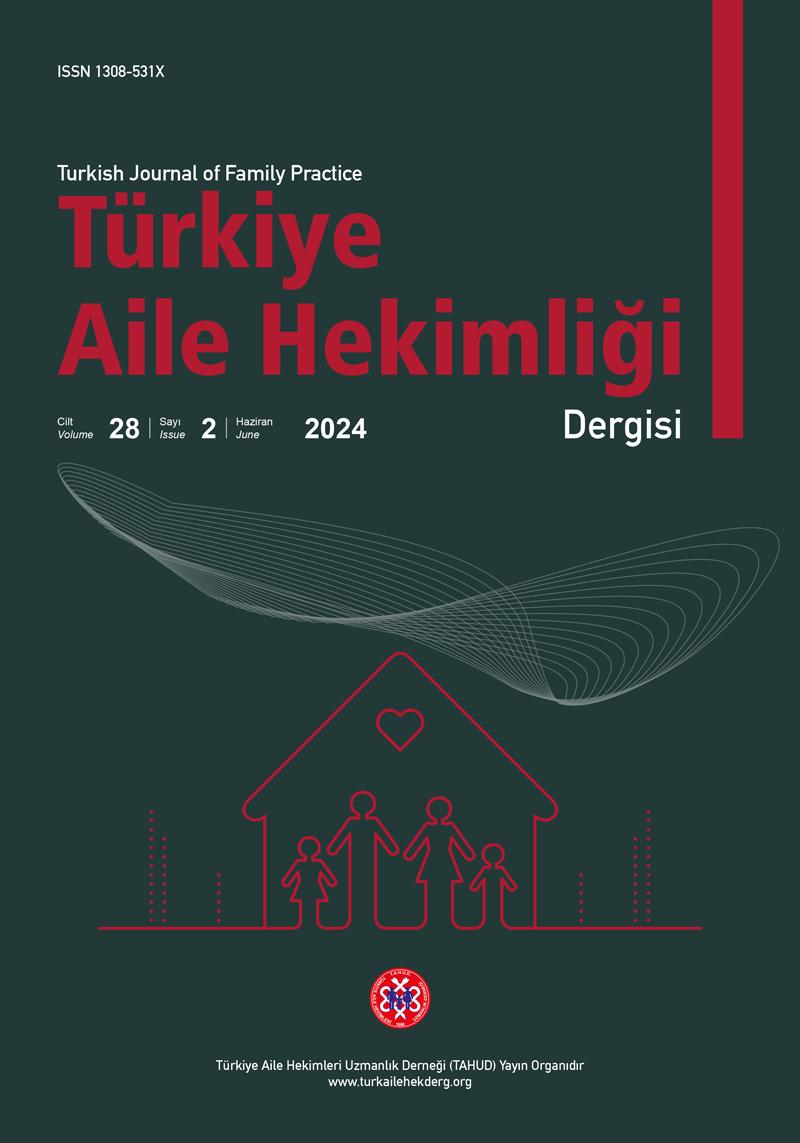Öz
Amaç: Bu çalışmada, birinci basamak sağlık hizmetlerine başvuran Tip 2 diyabetli hastalarda idrarda albüminüri sıklığının belirlenmesi ve albüminüriyi etkileyen faktörlerin değerlendirilmesi amaçlanmıştır.
Yöntem: Araştırma, Samsun ili Vezirköprü ilçesi Kanyon Aile Sağlığı Merkezi’nde 01.06.2020-31.08.2020 tarihleri arasında kesitsel ve tanımlayıcı bir çalışma olarak gerçekleştirilmiştir. Araştırmaya 211 birey dahil edilmiştir. Katılımcıların bilgilendirilmiş onamı alındıktan sonra sosyodemografik özellikleri, kronik hastalıkları, sigara kullanımı ve kullandığı ilaçların sorgulandığı çalışma formu yüz yüze uygulanmıştır. Albüminüri tespiti için test şeritleri kullanılmış olup, stripteki renk değişimi her defasında aynı araştırmacı tarafından gün ışığında değerlendirilerek anlık spot idrarda albümin/kreatinin oranı yaklaşık olarak hesaplanmıştır. Verilerin analizi SPSS 24.0 (SPSS 24.0 for Windows, SPSS Inc., Chicago, IL, ABD) programı ile gerçekleştirilmiştir.
Bulgular: Araştırmaya katılanların %52,1’i (n=110) kadındı. Yaş ortalaması 59,8±13,3 yıldı (min: 25-maks: 80). Hastaların %47,4’ünde hipertansiyon, %27’sinde aterosklerotik kalp hastalığı, %23,7’sinde hiperlipidemi, %22,7’sinde obezite, %2,4’ünde serebrovasküler hastalık tanısı mevcuttu. Bireylerin diyabet tanı alma süreleri değerlendirildiğinde, %27,5’inin 0-5 yıl, %26,6’sının 6-10 yıl, %15,6’sının 11-15 yıl, %14,2’sinin 16-20 yıl, %16,1’inin 20 yıldan fazla olduğu görüldü. Ek olarak, %39,3’ü son 6 aydır düzenli sigara kullanmaktaydı, %37’si ise yaşamında hiç sigara kullanmamıştı. Spot idrarda albümin/kreatinin oranı değerlendirildiğinde; %78,7’sinde (n=166) normoalbüminüri, %19’unda (n=40) mikroalbüminüri, %2,4’ünde (n=5) makroalbüminüri olduğu belirlendi. İleri yaşta, diyabet yılı fazla olan ve daha önceden sigara kullanımı olan hastaların mikroalbüminüri ve makroalbüminüri görülme oranı anlamlı derecede yüksekti (tümü; p<0,001). Yaş, diyabet süresi, hipertansiyon, obezite ve albüminüri arasında pozitif korelasyon bulundu (sırasıyla r: 0,48, r: 0,68, r: 0,47, r: 0,55; p<0,05). Geçmişte sigara içme öyküsü olan hastaların mikroalbüminüri düzeyleri son 6 aydır sigara içen ve hiç sigara içmeyenlere göre daha yüksekti (p<0,05). 16-20 yıl ve 20 yıl üzeri Tip 2 diyabet tanısı ile takipli hastaların mikroalbüminüri düzeyleri, daha yeni tanı alan hastalara göre daha yüksekti (p<0,001).
Sonuç: Çalışmamızda yaş, diyabet tanı süresi, hipertansiyon, obezite ve sigara içme öyküsü albüminüri ile ilişkili saptandı. Aile hekimleri, pratik tarama protokollerini entegre ederek ve hasta bakımına bütünsel bir yaklaşım benimseyerek, birinci basamak sağlık hizmetlerinde diyabetik nefropatinin yükünü azaltmada ve hasta sonuçlarını iyileştirmede önemli bir rol oynayabilir.
Anahtar Kelimeler: Birinci basamak sağlık hizmetleri, diyabet, nefropati, albüminüri
Telif hakkı ve lisans
Telif Hakkı © 2024 Yazar(lar). Açık erişimli bu makale, orijinal çalışmaya uygun şekilde atıfta bulunulması koşuluyla, herhangi bir ortamda veya formatta sınırsız kullanım, dağıtım ve çoğaltmaya izin veren Creative Commons Attribution License (CC BY) altında dağıtılmıştır.










